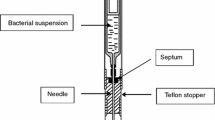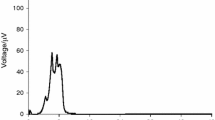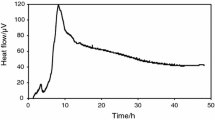Abstract
Microcalorimetry is a technique that determines the heat flow produced as a result of microbial activities. The heat variations resulting from chemical reactions, which take place during metabolism, can be used to monitor bacterial growth in a culture medium. However, there are very few studies using calorimetry to investigate the relationships between two bacteria. In this work, we studied the interaction between E. coli and P. mirabilis, two bacteria belonging to the family Enterobacteriaceae. We have prepared three samples, mixing both enterobacteria at a concentration of 103 CFU mL−1 but in different proportions. Experimental equipment used was a Calvet microcalorimeter, where a constant temperature of 309.65 K was maintained. Then, we compared the shape of the heat flow–time curves of single microorganisms and their mixtures. Also, we calculated the thermokinetic parameters such as growth constant (k), generation time (G), detection time (t d) and the amount of heat released (Q). The results obtained showed that when E. coli and P. mirabilis were put together in the culture medium, the growth profile of P. mirabilis seemed to dominate, even at low proportions in the sample.



Similar content being viewed by others
References
Brooks GF, Carroll KC, Butel JS, Morse SA. Microbiología Médica de Jawetz, Melnick y Adelberg. 25th ed. México: Mc Graw Hill; 2010.
Madigan M, Martinko J, Stahl D, Clark D. Brock biology of microorganisms. 13th ed. Boston: Pearson; 2012.
Winn W, Allen S, Janda W, Koneman E, Procop G, Schreckenberger P, et al. Koneman’s color atlas and textbook of diagnostic microbiology. 6th ed. Philadelphia: Lippincott Williams and Wilkins; 2006.
Braissant O, Wirz D, Göpfert B, Daniels AU. Use of isothermal microcalorimetry to monitor microbial activities. FEMS Microbiol Lett. 2010;303:1–8.
James AM. Calorimetry. Past, present and future. Thermal and energetic studies of cellular biological systems. Bristol: IOP Publishing Ltd; 1987.
Trampuz A, Steinhuber A, Wittwer M, Leib SL. Rapid diagnosis of experimental meningitis by bacterial heat production in cerebrospinal fluid. BMC Infect Dis. 2007. doi:10.1186/1471-2334-7-116.
Rodriguez D, Daniels AU, Urrusti JL, Wirz D, Braissant O. Evaluation of a low-cost calorimetric approach for rapid detection of tuberculosis and other mycobacteria in culture. J Appl Microbiol. 2011;111(4):1016–24.
Bonkat G, Braissant O, Widmer AF, Frei R, Rieken M, Wyler S, et al. Rapid detection of urinary tract pathogens using microcalorimetry: principle, technique and first results. BJU Int. 2012;110(6):892–7.
Trampuz A, Salzmann S, Antheaume J, Daniels AU. Microcalorimetry: a novel method for detection of microbial contamination in platelet products. Transfusion. 2007;47:1643–50.
Tan MR, Ren YS, Yan D, Meng XH, Cheng LH, Qiu LL, et al. Detection of microorganisms in different growth states based on microcalorimetry. J Therm Anal Calorim. 2012;109(2):1069–75.
Dai C, Wang J, Kong W, Peng C, Xiao X. Investigation of anti-microbial activity of catechin on Escherichia coli growth by microcalorimetry. Environ Toxicol Pharmacol. 2010;30(3):284–8.
Baldoni D, Steinhuber A, Zimmerli W, Trampuz A. In vitro activity of Gallium maltolate against Staphylococci in logarithmic, stationary, and biofilm growth phases: comparison of conventional and calorimetric susceptibility testing methods. Antimicrob Agents Chemother. 2010;54(1):157–63.
Kong W, Wang J, Xing X, Jin C. Screening for novel antibacterial agents based on the activities of compounds on metabolism of Escherichia coli: a microcalorimetric study. J Hazard Mater. 2011;185:346–52.
Shen XS, Liu Y, Zhou CP, Zhao RM, Qu SS. Microcalorimetric study on the antibiotic activity of clarithromycin and erythromycin. Wuhan Univ J Nat Sci. 2000;5(2):215–8.
von Ah U, Wirz D, Daniels AU. Isothermal micro calorimetry—a new method for MIC determinations: results for 12 antibiotics and reference strains of E. coli and S. aureus. BMC Microbiol. 2009. doi:10.1186/1471-2180-9-106.
Wang CY, Xu F, Sun LX, Sun YJ, Qiu SJ, Zhao ZB, et al. Influences of levofloxacin salts on the metabolism of Escherichia coli by microcalorimetry. J Therm Anal Calorim. 2012. doi:10.1007/s10973-012-2426-z.
Baldoni D, Hermann H, Frei R, Trampuz A, Steinhuber A. Perfomance of microcalorimetry for early detection of methicillin resistance in clinical isolates of Staphylococcus aureus. J Clin Microbiol. 2009;47:774–6.
Kong WJ, Xing ZY, Xiao XH, Zhao YL, Wei JH, Wang JB. Effect of berberine on Escherichia coli, Bacillus subtilis, and their mixtures as determined by isothermal microcalorimetry. Appl Microbiol Biotechnol. 2012;96:503–10.
Vázquez C, Lago N, Legido JL, Arias I, Casás LM, Mato MM. Microcalorimetric study of the growth of Enterococcus faecalis, Klebsiella pneumoniae and their mixtures in an enriched culture medium. J Therm Anal Calorim. 2013. doi:10.1007/s10973-013-3287-9.
Lago N, Legido JL, Arias I, García F. Aplicaciones de la microcalorimetría como método de identificación precoz del crecimiento bacteriano. Invest Cult Cienc Tecnol. 2010;2(3):6–9.
Lago N, Legido JL, Paz-Andrade MI, Arias I, Casás LM. Microcalorimetric study of the growth and metabolism of Pseudomonas aeruginosa. J Therm Anal Calorim. 2011;105:651–5.
Lago N, Legido JL, Casás LM, Arias I. Microcalorimetric study of the growth of Enterococcus faecalis in an enriched culture medium. J Therm Anal Calorim. 2012;108:665–70.
Lago N, Legido JL, Arias I, Casás LM. Comparative study of microcalorimetric behavior of Escherichia coli, Proteus mirabilis and Klebsiella pneumoniae. Pol J Microbiol. 2012;61(3):199–204.
Acknowledgements
We thank María Perfecta Salgado Gonzalez and Sofia Baz Rodríguez for their collaboration with the technical measures. We are also thankful for the financial support provided by the projects EM 2012/141, CN 2012/285, and ‘Agrupación Estratégica de Biomedicina (INBIOMED)’ by ‘Xunta de Galicia’ and the project FIS 2011-23322 funded by Ministry of Science and Innovation of Spain. All these projects are co-financed with FEDER funds.
Author information
Authors and Affiliations
Corresponding author
Rights and permissions
About this article
Cite this article
Vazquez, C., Lago, N., Mato, M.M. et al. Microcalorimetric performance of the growth in culture of Escherichia coli, Proteus mirabilis and their mixtures in different proportions. J Therm Anal Calorim 116, 107–112 (2014). https://doi.org/10.1007/s10973-013-3535-z
Received:
Accepted:
Published:
Issue Date:
DOI: https://doi.org/10.1007/s10973-013-3535-z




